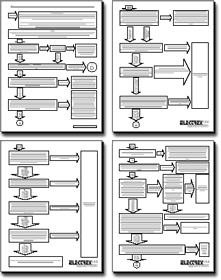|
|
||||||||||||||||||||||||||||||
|
||||||||||||||||||||||||||||||
 |
 |
|||||||||||||||||||||||||||||
|
Technical Article: Motorcycle Electrical Fault Finding GuideHow to Diagnose Electrical System Issues on MotorcyclesAny well-working modern motorcycle charging system will produce a voltage over the battery terminals in between 13.5V DC and 14.5V DC, over the entire rev range. When you suspect a fault in the system, this is the first thing to check on your bike. When you find that there is a problem, keep in mind that the number 1 problem with any charging system are bad connections. Suspect any connection in the entire system. It's advisable to take off all fairing parts, the fuel tank and seat, and just disconnect all connectors you can find. Do these one at a time, and spray them with a contact cleaner before fitting the connector again. On the widely used bullet connectors, the ones used on many Japanese bikes for connecting single wires to each other, you should see if the male bullet connector needs a firm push when it slides into the female one. If not, use a pair of pliers to make the fit tighter in the female connector. When you disconnect them one at a time, nothing can go wrong. You will see that the wires are color coded, so mistakes when refitting the connectors are almost impossible. The use of our universal fault finding chart is a good way of finding the fault in most of the charging systems on motorcycles. Go through the tests step by step, following the procedure accurately. If you're not completely sure that you have the basic knowledge required with electrical systems on motorcycles, don't do the tests yourself, but find someone experienced in this field to help you. Download Electronicamotos's Motorcycle Electrical Fault Finding Chart (PDF) *Standard PDF files are viewable on Adobe Reader (free).  « Technical Resources Library :: Diagnosis Center
|
|||||||||||||||||||||||||||||
|
© 2010 - 2023 - www.Electronicamotos.com.ar - Buenos Aires - Argentina |
||||||||||||||||||||||||||||||


